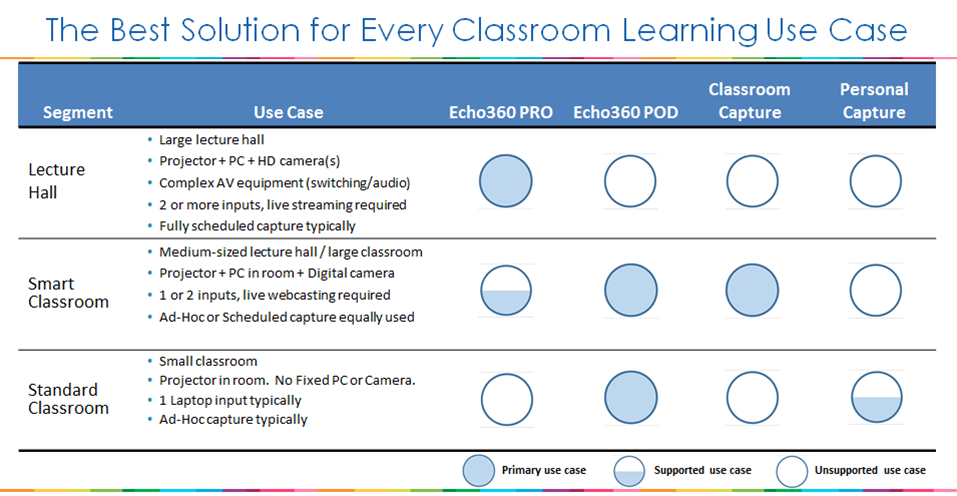Professor Brings the Lecture Back to Life

We recently sat down with Jon Patterson, DVM, PhD, DAVCP, Professor at Michigan State University’s College of Veterinary Medicine. Dr. Patterson teaches over 100 students in two large lecture classes, including Neuroscience and General Pathology. We asked him about challenges and successes related to student learning in his large lecture classes and how his teaching has evolved with the support of new student engagement and active learning technologies. Here’s what he had to say.
What specific academic challenges are you addressing with active learning strategies in your classroom?
I wanted to improve student participation and engagement. I have always wanted to interact more with students during class, especially during the large lecture classes. Prior to using the student engagement features in Echo360, what I observed was that only a small percentage of students would participate – only 10-12 students out of more than 100 throughout the entire semester. Echo360 helps me get more of my students actively involved and engaged.
How are you incorporating technology into your teaching process to improve student engagement and class participation?
Before class, I ask students to review prepared lecture notes and answer questions about specific clinical case examples. During class I present a mini-lecture highlighting the case that ranges from 5 to 25 minutes in length. The mini-lecture consists of a PowerPoint presentation contained within the Echo360 platform. I use Echo360’s student engagement features to ask students questions either at the beginning of the lecture, interspersed throughout, or at the end of the lecture to summarize the main points I have made. Students participate by answering the questions and then we discuss their answers in class, which helps to clear up points of confusion and improves student understanding of the material.
Have you seen increases in student participation?
Yes, I get nearly 100 percent student participation in class now. This is up from only about 10-12 percent participation before.
One of the things students really like about Echo360 is the ability for students to anonymously answer questions. It’s a good feature because they aren’t afraid of embarrassing themselves in front of their classmates this way. Students can earn up to one percentage point of their final grade if they participate actively. The system lets me keep track of the student participation over the course of the semester. Participation gets added to their final grade at the end of the term.
You’ve had a significant increase in student participation. Has there been a corresponding increase in student outcomes?
This is my first full semester using the Echo360 active learning platform so I am just now starting to look at the rich data and analytics provided in the platform. I have not completed the analysis yet, but just from looking at the data, it appears that students who participate at a higher level perform better on exams. Students who received lower grades didn’t participate as much. As I use the system more in subsequent terms, I will continue to analyze the student learning and behavioral data collected by Echo360 to see if there is a significant correlation there.
Why is student engagement so important?
I try to stress that it is not just about getting a higher percentage point on their grade. I believe that participation and active engagement fosters better retention and a deeper understanding of the concepts. After the students answer the questions, I share the results in front of the entire class. We discuss the right answers and the incorrect answers, which helps to clear up points of confusion.
You’ve encouraged and rewarded students to participate more in your classes – whether they are physically in class or at home. What’s been their reaction?
Students generally like participating in this way. They would much rather participate in the class than just sit there and listen to a lecture. I also record and “live-stream” lectures using Echo360. Many students prefer watching the lectures from home, because it may be more convenient for them. But they are still able to participate and answer questions – even from home – so this is why I can say I’m getting close to 100 percent participation even though only 60 or 70 students may be physically present in the lecture hall. Students also use Echo360 to review lectures prior to exams. The playback features allow students to set the speed at which they listen. They can go back and re-listen to portions of the lectures as often as they wish, which is a very helpful tool for them to have.
How has using Echo360 affected your teaching?
In the past, I relied solely on written hand-outs that included the questions that we would discuss in class. Now, what I have done is taken some of those questions and incorporated them into my presentation within Echo360. Since I’ve changed the way in which I ask these questions and students can answer anonymously, I’ve gotten more students to participate. I have also tailored my lecture presentations to ensure that I have time for student participation.
In the future I hope to use the system even more. The students really like it and I believe that it helps them learn with greater understanding.
What advice would you give to others looking to increase student participation and engagement with new technologies?
One perception is that instructors think that using systems like Echo360 will take time away from the information they believe they have to cover in a 50 minute lecture. They think if they take five minutes to ask a few student questions, it will take time away from the content. However, my experience as a professor has shown me that “less is more” when lecturing. Students aren’t going to walk away from a 50 minute lecture with more than three or four main concepts. So, my goal is to make sure they really understand those three or four concepts really well. My hope is that students can walk away from my lectures now with a deeper understanding as a result of greater engagement in class.


